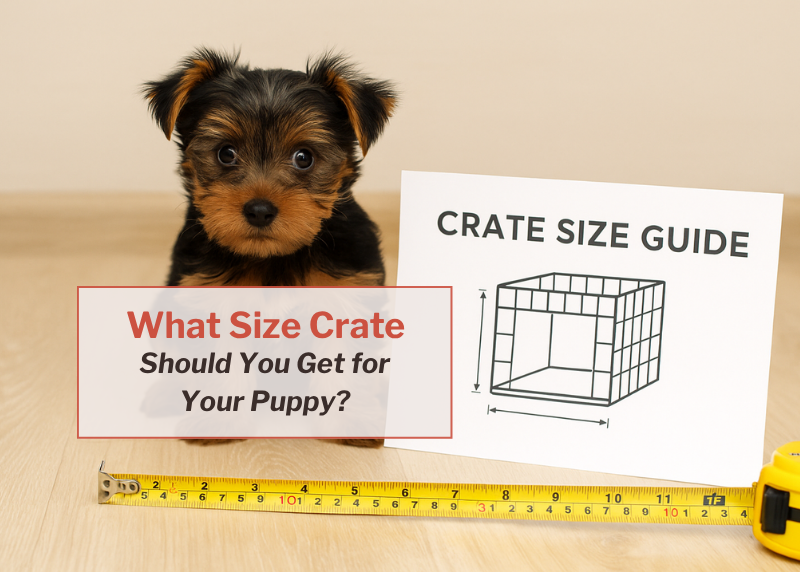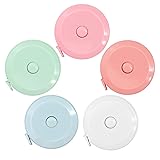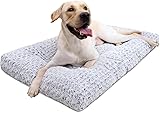Getting the right size crate for your puppy isn’t just a matter of convenience—it’s essential for comfort, safety, and effective training. If you’re feeling unsure or overwhelmed, you’re not alone. Many first-time pet parents wonder how big a crate should be, what kind to get, and how to set it up for success. This guide breaks it all down for you.
PS. Make sure to scroll all the way to the bottom for a chart visual as well as the FAQ section!
Why Crate Size Matters for Your Puppy
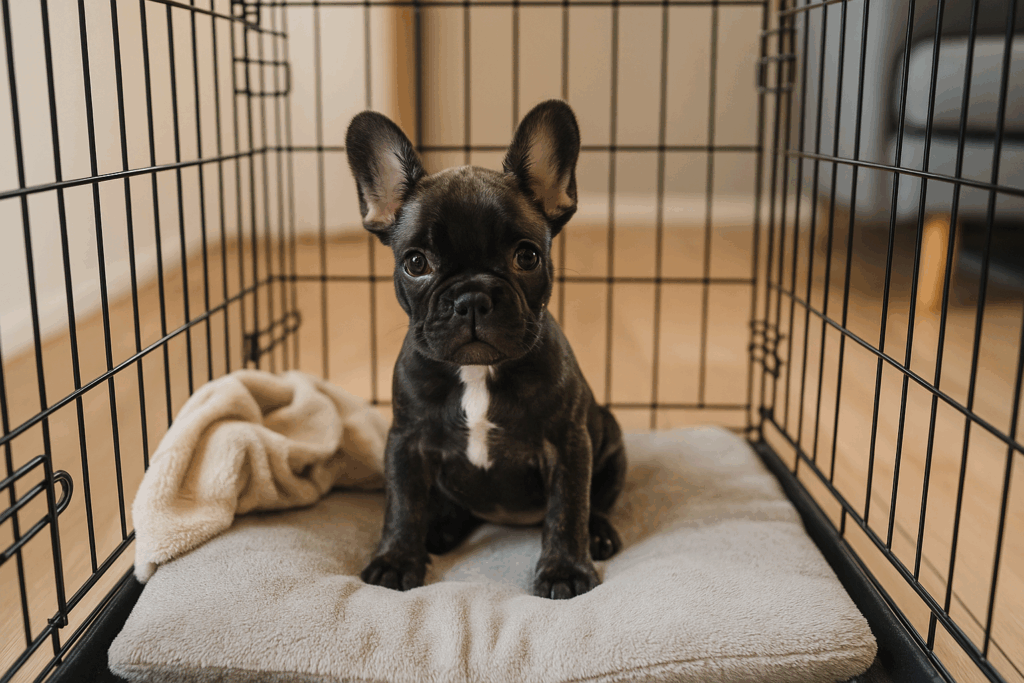
Choosing the correct crate size is one of the first and most important decisions you’ll make as a new pet parent. It’s not just about where your dog sleeps—crate size impacts their behavior, training, and emotional well-being. Too small, and it’s uncomfortable; too big, and it could delay potty training.
Supports Potty Training
A properly sized crate prevents your puppy from eliminating in one corner and sleeping in another. The limited space encourages them to “hold it,” reinforcing good potty habits.
Curious how to best potty train small dog breeds? check this out here
Creates a Safe, Cozy Haven
Puppies are den animals by nature. A crate that’s just the right size feels like a secure nest, not an overwhelming space or a cramped box.
Prevents Anxiety and Stress
Too much room can make a puppy feel exposed, while too little can feel restrictive. The right fit helps your pup settle calmly, reducing whining, pacing, or stress-related behaviors.
Reduces Destructive Behavior
When your puppy feels comfortable and secure in their crate, they’re less likely to scratch, chew, or panic. This sets the tone for calm, independent time.
Makes Training More Effective
From feeding routines to quiet time, crate training is smoother when your puppy’s crate feels like a familiar, well-sized part of their world—leading to faster, more positive results.
How to Choose the Right Dog Crate Size
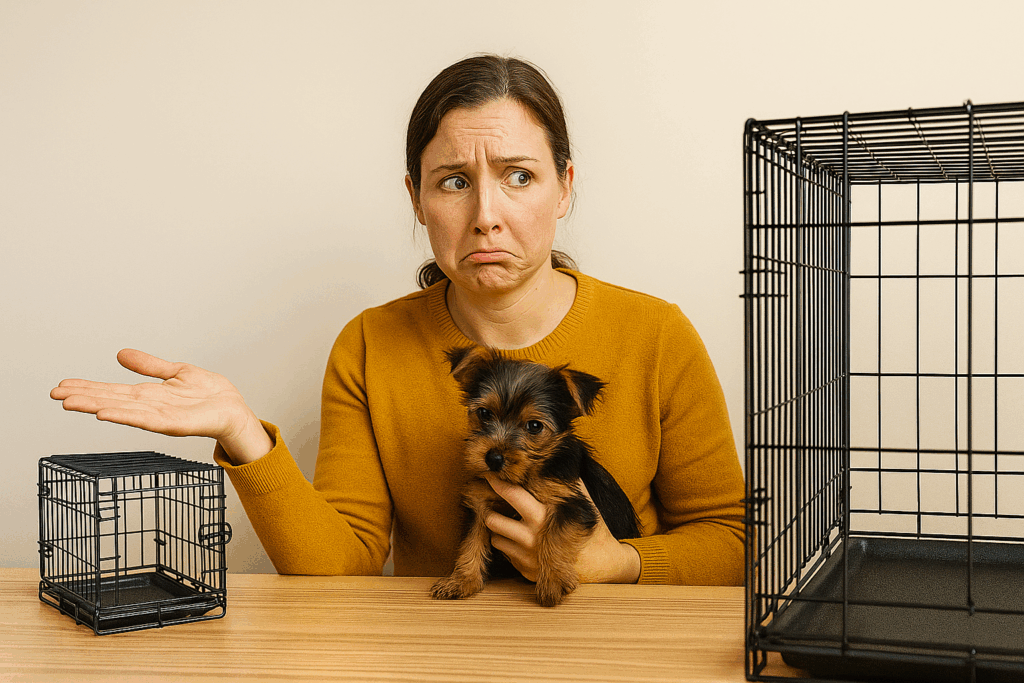
There isn’t a one-size-fits-all answer when it comes to dog crates. Your puppy’s breed, age, and future size all play a role. This section helps you take measurements, plan ahead, and choose the right crate from the start—or grow into one without issues.
The Most Important Thing About Crate Fit
The crate should be snug but not cramped. A crate that is too large encourages potty accidents because your puppy may treat one end as a bathroom and the other as a bed. The right dog crate size limits that instinct while still providing comfort.
How Much Space Is Too Much? Or Not Enough?
If your puppy can’t turn around easily or has to crouch, it’s too small. If they can pace or eliminate in one corner and sleep in another, it’s too big. Most crates come with sizing guidelines based on weight and breed, but your puppy’s actual measurements and age are more reliable.
Measuring Your Puppy (and Planning for Growth)
Use a soft tape measure to get your puppy’s length (nose to tail base) and height (floor to top of the head or ears, whichever is taller). Add 2-4 inches to each to find the ideal crate dimensions. For growing puppies, consider buying an adult-size crate and using a crate divider.
Should You Buy the Adult Size Now?
Yes—with a crate divider. Large breed puppies, in particular, grow fast, and using a larger crate with a divider helps you avoid buying multiple crates. Adjust the divider as your dog grows to maintain that “just right” space.
Wire vs. Plastic Crates: What’s Better for Puppies?
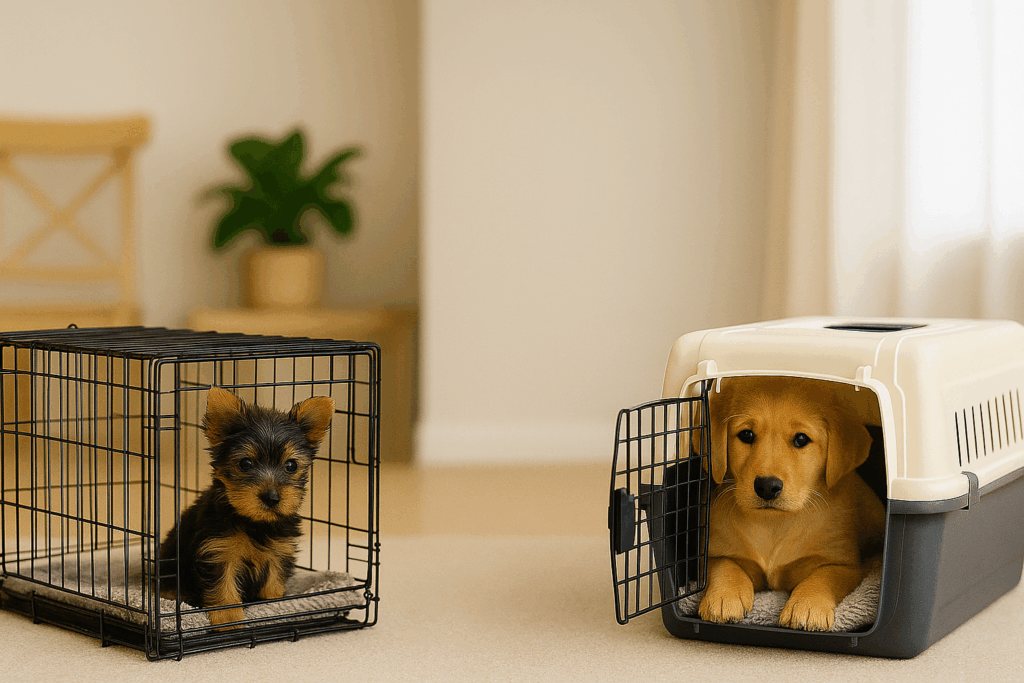
When shopping for a crate, you’ll likely choose between wire and plastic. Both have pros and cons depending on your dog’s needs and your lifestyle. Here’s how to decide which one works best for your situation and your pup’s temperament.
Why Wire Crates Are a Good Option for First-Time Pet Owners
Wire crates are popular because they are breathable, foldable, and adjustable. Many come with dividers and allow your puppy to see their surroundings—helpful for puppies who enjoy being in the family room or living room.
- 42-inch dog crate for pets under 38 x 26 inches (LxH), like…
- Durable metal wire construction with manual door locking…
- Sets up quickly and folds down flat for easy transport or…
When a Plastic Crate Might Be the Safer Choice
Plastic crates are cozier and more enclosed, which can help anxious puppies feel safe. They’re also a good option for travel. For some pups, a plastic crate with a soft blanket and favorite toy creates an ideal safe space. These crates are especially useful for short trips to the vet, car rides, or situations where a wire crate might feel too exposed. Plus, they often have a more den-like atmosphere naturally, which many dogs find comforting, especially during the early crate training process. Plastic crates are cozier and more enclosed, which can help anxious puppies feel safe. They’re also a good option for travel. For some pups, a plastic crate with a soft blanket and favorite toy creates an ideal safe space.
- FIRST-CLASS COMFORT FOR PETS: The Petmate Sky Kennel meets…
- EASY TRAVEL PREPARATION: The Sky Kennel is a travel dog…
- SPACIOUS INTERIOR FOR SMALL DOGS AND CATS: Ideal for…
Creating a Positive Association With the Crate
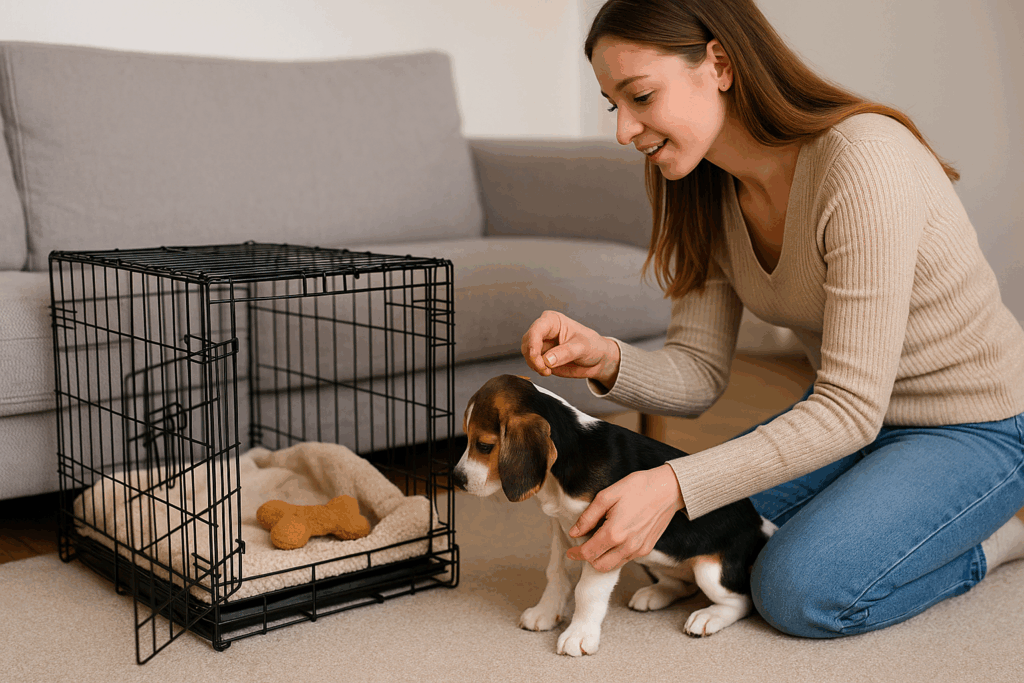
A crate shouldn’t feel like a cage—it should feel like a bedroom. Making the crate a place your puppy wants to go is critical to long-term success. This section gives tips on turning the crate into your dog’s favorite spot in the house.
Using a Soft Blanket, Toys, and Comfy Beds Inside the Crate
Place a comfy bed, a self-soothing toy, or a little soft blanket inside. These promote quiet time and help build pleasant associations. Think of it as your pup’s personal bedroom.
Keep the Crate away from the Family Room or Living Room
Location matters. Placing the crate in a busy area of your house where your puppy can still see you—might make them more anxious about being contained. Instead, move nap time to a room where they can’t see or hear you. Covering the crate with a blanket or crate cover helps your puppy wind down faster too.
Use a Happy Tone of Voice and Avoid Sign of Fear
When introducing the crate, speak in an enthusiastic way. Praise your puppy when they enter the crate on their own. Never force them in—this should always feel like a good idea to them.
How Long Should Puppies Stay in Their Crates?
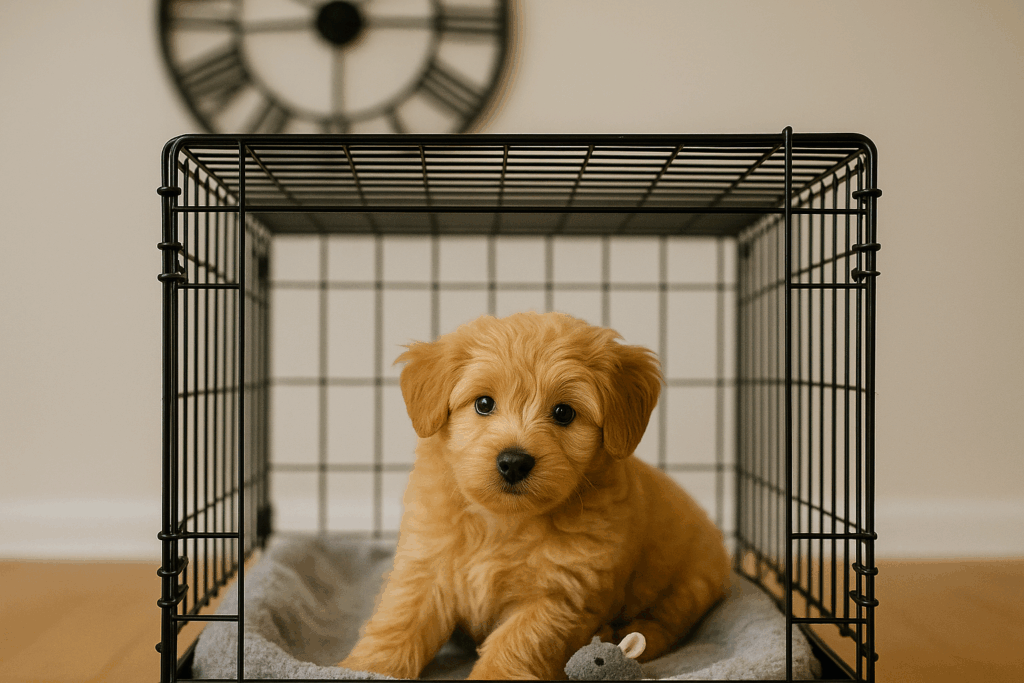
Timing is everything. Knowing how long your puppy can safely stay in a crate helps prevent stress, accidents, and behavior problems. Learn what’s appropriate by age and situation—and how to build healthy habits around crate time.
Short Time vs. Long Periods of Time: What’s Safe?
Young puppies should only be crated for short periods of time. A general rule: one hour for every month of age (e.g., a 3-month-old = 3 hours max). Over-crating can cause separation anxiety or even destructive behaviors.
Going to work? Check out –> Should You Crate Your Dog While at Work? Pros & Cons Explained
Crate Training for Young Puppies vs. Older Dogs
Young puppies need more frequent potty breaks and supervised crate time. Older dogs can usually handle longer periods. Still, adult dogs should not be left in a crate all day without breaks.
Managing Potty Breaks, Quiet Time, and Separation Anxiety
Stick to regular meals and schedule potty breaks. Avoid using the crate as a time-out or punishment. For separation anxiety, gradually increase crate time and ensure your puppy sees it as a safe haven.
Crate Setup Tips for Pet Parents
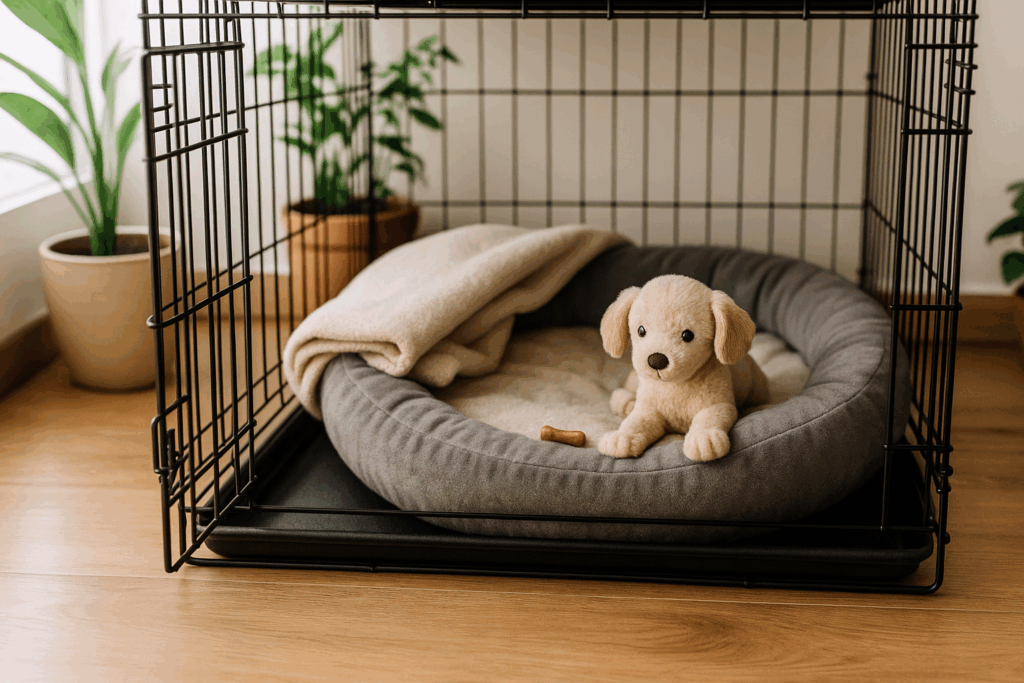
Where you place the crate, what you put inside it, and how you decorate around it all play a role in your puppy’s comfort and success. Set your puppy up for calm naps, quiet time, and positive experiences with these easy-to-follow setup tips.
Where to Place the Crate: Best Spot in the House
Avoid high-traffic or loud areas such as the kitchen, living room, or close to the front door, where there might be more noise. The preferred location is somewhere calm and possibly dark, like a bedroom, bathroom, or walk-in closet, where to door can be closed and lights turned off.
What to Put Inside: Soft Blankets, Dog Beds & More
Include a comfy bed, small blanket, and maybe your puppy’s favorite toy. These create a cozy atmosphere and encourage your puppy to relax. Puzzle feeders and interactive toys can also keep your dog busy and help reduce anxious energy. For added comfort, you can use soft blankets that smell like you or your home to reinforce the crate as a safe space. Avoid hard surfaces and slippery pads—your puppy should feel stable and secure while resting.Include a comfy bed, small blanket, and maybe your puppy’s favorite toy. Some pet parents use crate covers to block distractions and create a cozy feel—just be sure there’s good airflow.
Don’t Forget the Crate Cover for a Safe Haven Feel
Crate covers can help puppies sleep better, especially in the middle of the night. They provide a den-like atmosphere, making the crate feel more secure.
Crate Sizing Chart
| Crate Size (L x W x H) | Dog Weight | Dog Length | Dog Height | Breed Example |
| 18” x 12” x 14” | Up to 6 pounds | Up to 10 inches | Up to 10 inches | Teacup Chihuahua |
| 22” x 14” x 16” | Up to 12 pounds | Up to 16 inches | Up to 12 inches | Yorkies |
| 24” x 18” x 20” | 13–25 pounds | Up to 18 inches | Up to 14 inches | Bichon |
| 30” x 20” x 23” | 26–40 pounds | Up to 24 inches | Up to 18 inches | French Bulldog |
| 36” x 24” x 26” | 41–70 pounds | Up to 30 inches | Up to 20 inches | Australian Cattle dog |
| 42” x 28” x 30” | 71–90 pounds | Up to 36 inches | Up to 24 inches | Golden Retriever |
| 48” x 30” x 32” | 90–110 pounds | Up to 42 inches | Up to 26 inches | Bernese Mountain dog |
Frequently Asked Questions About Crate Size
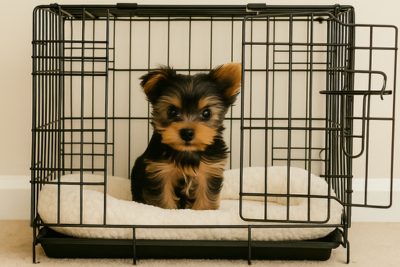
1. How much room should a puppy have in a crate?
Just enough to stand, turn around, and lie down comfortably—no more. Too much space can slow potty training.
2. Should I buy a crate based on my puppy’s current size or full-grown size?
Buy one for their adult size, but use a divider to adjust the space while they grow.
3. How do I measure my puppy for the right crate?
Measure from nose to tail base and floor to top of head/ears. Add 2–4 inches to both.
4. Is a bigger crate always better?
Not necessarily. Oversized crates can encourage bathroom accidents and reduce the feeling of security.
5. What’s better for puppies—plastic or wire crates?
It depends. Wire crates are adjustable and open; plastic crates feel cozier and more enclosed.
6. Can I use the crate for naps and nighttime sleep?
Yes! Just make sure it feels cozy, safe, and is never used for punishment. To read more about this crate naps go here: Daytime Puppy Naps: Should He Be in His Crate or Not?
7. What should I put inside the crate?
A soft blanket or bed, a favorite toy, and optionally a crate cover for a den-like feel.
8. How long can I leave my puppy in the crate?
About one hour per month of age (e.g., 3-month-old = 3 hours max).
9. Where should I place the crate in my home?
Somewhere quiet and away from family activity—like the bedroom, bathroom or a walk-in closet.
10. What if my puppy whines or won’t go in?
Start slow, use treats and praise, and make it a positive experience. Patience and consistency are key.
Final Thoughts for First-Time Puppy Parents
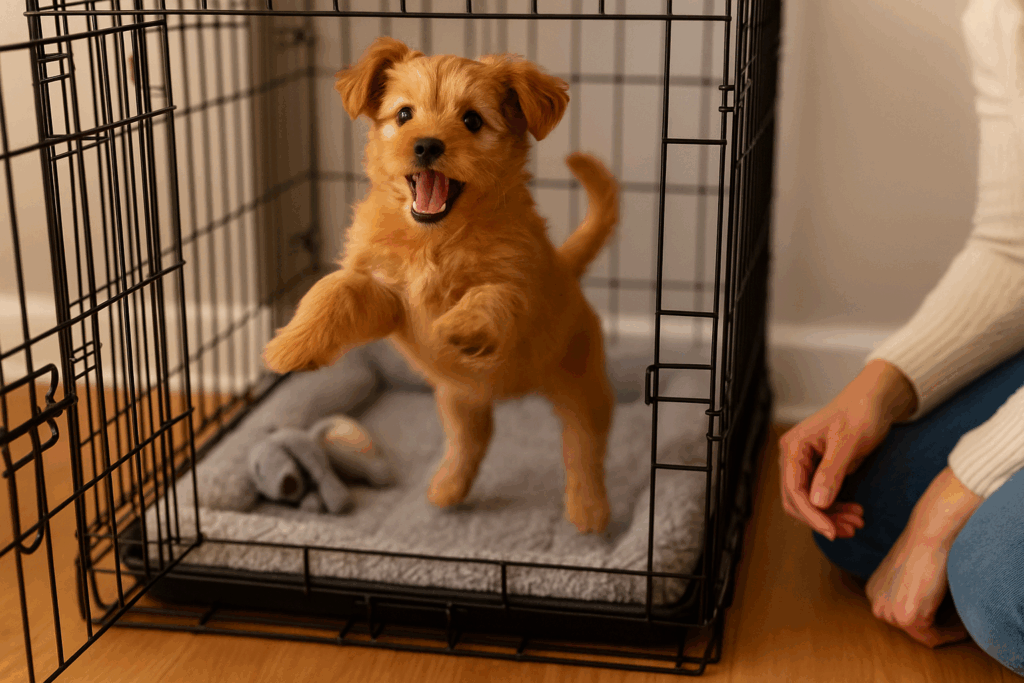
Choosing the right crate size can feel like a big decision—because it is! As a new pet parent, you want to do everything right for your pup, and that starts with making their crate feel like a secure, comfortable part of their daily life. From supporting potty training to encouraging calm naps and quiet time, the right-sized crate makes a world of difference.
Remember: it’s not about perfection, but about creating a space where your puppy can feel safe, grow in confidence, and thrive. With the tips in this guide, you’re already well on your way to making a choice that sets both of you up for success.

